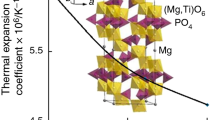Abstract
New approach of phosphate–sulfate synthesis, preventing sulfur elimination was proposed. It implies sulfur encasement into intermediate with heightened thermal resistance, thus the synthesis temperature of phosphate–sulfate could be increased, and crystallization can be performed. This method is considered to be capable by example of obtaining of Pb2/3FeZr(PO4)7/3(SO4)2/3 ceramic. It was synthesized by means of sol–gel method via formation of intermediate PbSO4, which encased sulfur and eventually led to formation of mentioned before phosphate–sulfate. Obtained sample was characterized via X-ray, IR, combined DTA–TG, SEM and microprobe electron analysis. Crystal structure and unit cell parameters were derived from least-squares refinement of powder X-ray diffraction data (NZP-type, sp. gr.\({\text{R}}\bar{3}{\text{c}}\), a = 8.6339 Å, c = 23.2991 Å, V = 1504.1 Å3). Thermal expansion (α a = 0.96·10−6, α c = 3.24·10−6, α av = 1.76·10−6 K−1) of compound also has been studied. There is a wide area of interest, due to development of ceramics with low thermal expansion.
Graphical Abstract








Similar content being viewed by others
References
Pet’kov VI, Asabina EA, Sukhanov MV, Schelokov IA, Shipilov AS, Alekseev AA. Design and characterization of phosphate-containing ceramics with Kosnarite- and Langbeinite-type structures for industrial applications. Chem Eng Trans. 2015;43:1825–30.
Anantharamulu N, Koteswara Rao K, Rambabu G, Vijaya Kumar B, Radha V, Vithal M. A wide-ranging review on Nasicon type materials. J Mater Sci. 2011;46:2821–37.
Pet’kov VI. Complex phosphates formed by metal cations in oxidation states I and IV. Russ Chem Rev. 2012;81:606–37.
Arbi K, Bucheli W, Jimenez R, Sanz J. High lithium ion conducting solid electrolytes based on NASICON Li1+xAlxM2−x(PO4)3 materials (M = Ti, Ge and 0 ≤ x ≤ 0.5). J Eur Ceram Soc. 2015;35:1477–84.
Pet’kov VI, Asabina EA, Shchelokov IA. Thermal expansion of NASICON materials. Inorg Mater. 2013;49:502–6.
Bohre A, Awasthi K, Shrivastava OP. Immobilization of lanthanum, cerium, and selenium into ceramic matrix of sodium zirconium phosphate. Radiochemistry. 2014;56:385–91.
Kim J, Jo SH, Bhavaraju S, Eccleston A, Kang SO. Low temperature performance of sodium–nickel chloride batteries with NASICON solid electrolyte. J Electroanal Chem. 2015;759:201–6.
Pet’kov V, Asabina E, Loshkarev V, Sukhanov M. Systematic investigation of the strontium zirconium phosphate ceramic form for nuclear waste immobilization. J Nucl Mater. 2016;471:122–8.
Ilin AB, Orekhova NV, Ermilova MM, Yaroslavtsev AB. Catalytic activity of LiZr2(PO4)3 nasicon-type phosphates in ethanol conversion process in conventional and membrane reactors. Catal Today. 2016;268:29–36.
Ivanov-Shitz AK, Murin IV. Ionika tverdogo tela (Solid-State Ionics). St. Petersburg: Gos. Univ; 2001.
Pérez-Estébanez M, Isasi-Marín J, Többens DM, Rivera-Calzada A, León C. A systematic study of Nasicon-type Li1+xMxTi2−x(PO4)3 (M: Cr, Al, Fe) by neutron diffraction and impedance spectroscopy. Solid State Ion. 2014;266:1–8.
Ortiz GF, López MC, Lavela P, Vidal-Abarca C, Tirado JL. Improved lithium-ion transport in NASICON-type lithium titanium phosphate by calcium and iron doping. Solid State Ion. 2014;262:573–7.
Liu XS, Li F, Song WB, Yuan BH, Cheng YG, Liang EJ, et al. Control of reaction processes for rapid synthesis of low-thermal-expansion Ca1−xSrxZr4P6O24 ceramics. Ceram Int. 2014;40:6013–20.
Pet’kov VI, Shipilov AS, Sukhanov MV. Thermal Expansion of MZr2(AsO4)3 and MZr2(TO4)x(PO4)3−x (M = Li, Na, K, Rb, Cs; T = As, V). Inorg Mater. 2015;51:1179–85.
Pet’kov VI, Orlova AI. Crystal chemical approach to predicting the thermal expansion of compounds in the NZP family. Inorg Mater. 2003;39:1013–23.
Pet’kov VI, Orlova AI, Kasantsev GN, Samoilov SG, Spiridonova ML. Thermal expansion in the Zr and 1-, 2-valent complex phosphates of NaZr2(PO4)3 (NZP) structure. J Therm Anal Calorim. 2001;66:623–32.
Oikonomou P, Dedeloudis C, Stournaras CJ, Ftikos C. [NZP]: a new family of ceramics with low thermal expansion and tunable properties. J Eur Ceram Soc. 2007;27:1253–8.
Pet’kov VI, Asabina EA. Thermophysical properties of NZP ceramics (a review). Glass Ceram. 2004;61:233–9.
Lenain GE, McKinstry HA, Alamo J, Agraval DK. Structural model for thermal expansion in MZr2P3O12 (M = Li, Na, K, Rb, Cs). J Mater Sci. 1987;22:17–22.
Pet’kov VI, Asabina EA, Markin AV, Smirnova NN. Synthesis, characterization and thermodynamic data of compounds with NZP structure. J Therm Anal Calorim. 2007;91:155–61.
Malecki S. Reduction of lead and zinc sulfates by hydrogen. J Therm Anal Calorim. 2015;121:861–6.
Dey A, Das Gupta A, Basu D, Ambashta RD, Wattal PK, Kumar S, Sen D, Mazumber S. A comparative study of conventionally sintered, microwave sintered and hot isostatic press sintered NZP and CZP structures interacted with fluoride. Ceram Int. 2013;39:9351–9.
Kim Y-I, Izumi F. Structure refinements with a new version of the Rietveld-refinement program RIETAN. J Ceram Soc Jpn. 1994;102:401–4.
Rietveld HM. Line profiles of neutron powder-diffraction peaks for structure refinement. Acta Crystallogr. 1967;22:151–2.
Izumi F. The Rietveld method. Young RA, editor. Oxford: Oxford Univ. Press; 1993.
Eremin NN, Sukhanov MV, Pet’kov VI, Urusov VS. Interatomic potentials for structural modeling of double alkali-metal zirconium orthophosphates. Dokl Chem. 2004;396:107–10.
Piffard Y, Verbaere A, Kinoshita M. β-Zr2(PO4)2SO4: a zirconium phosphato-sulfate with a Sc2(WO4)3 structure. A comparison between garnet, nasicon, and Sc2(WO4)3 structure types. J Solid State Chem. 1987;71:121–30.
Miyazaki H, Ushiroda I, Itomura D, Hirashita T, Adachi N, Ota T. Thermal expansion of NaZr2(PO4)3 family ceramics in a low-temperature range. Jpn J Appl Phys. 2008;47:7262–5.
Acknowledgements
The present work was performed at the Lobachevsky State University of Nizhni Novgorod with the financial support of the Russian Foundation for Basic Research (Project No. 15-03-00716 a).
Author information
Authors and Affiliations
Corresponding author
Rights and permissions
About this article
Cite this article
Pet’kov, V.I., Dmitrienko, A.S., Sukhanov, M.V. et al. New approach of synthesis of phosphate–sulfates with NZP-type structure. J Therm Anal Calorim 127, 2093–2099 (2017). https://doi.org/10.1007/s10973-016-5724-z
Received:
Accepted:
Published:
Issue Date:
DOI: https://doi.org/10.1007/s10973-016-5724-z



